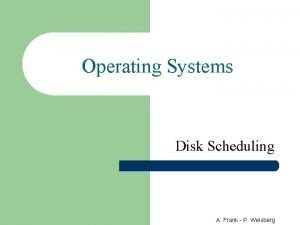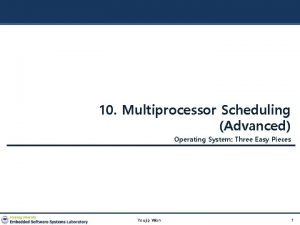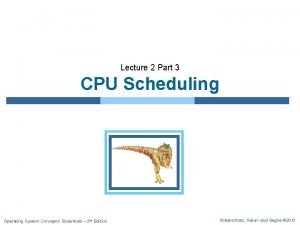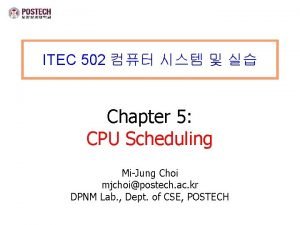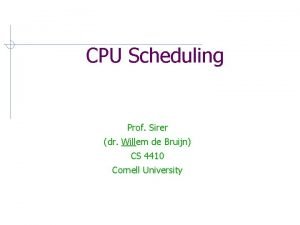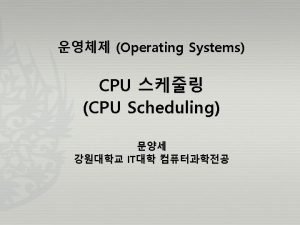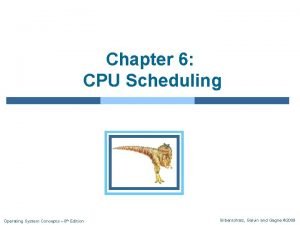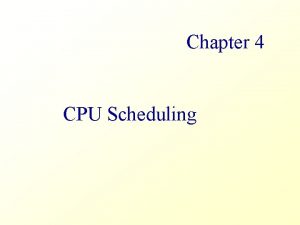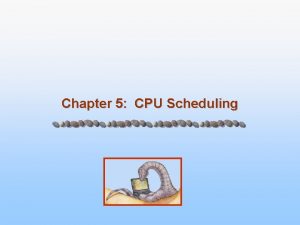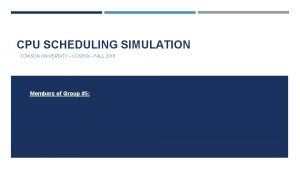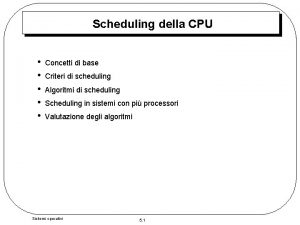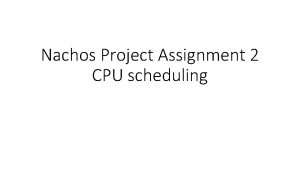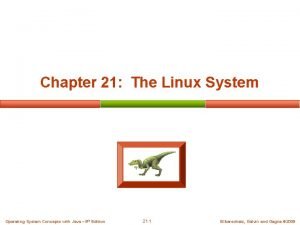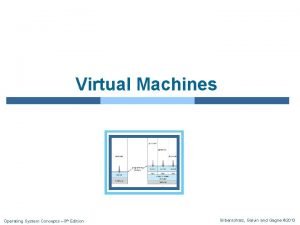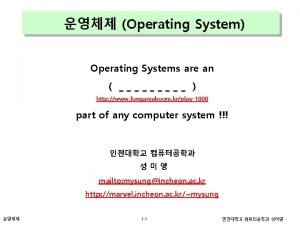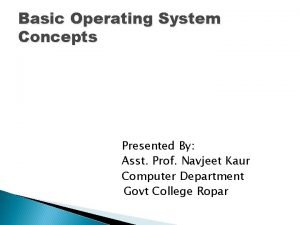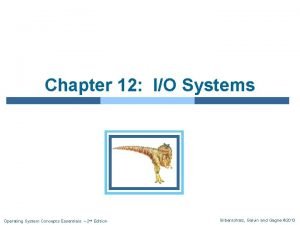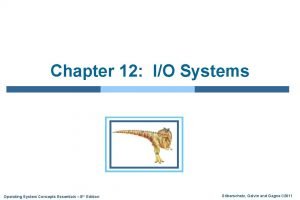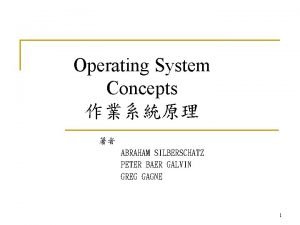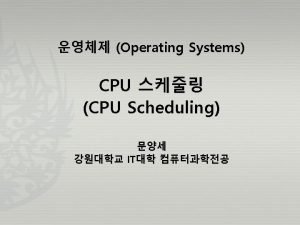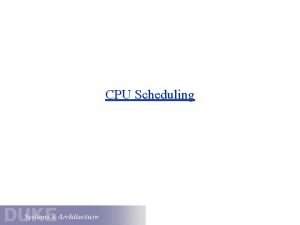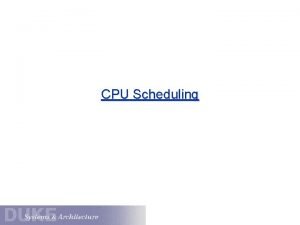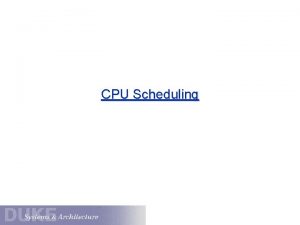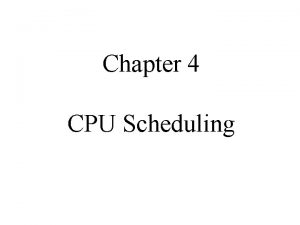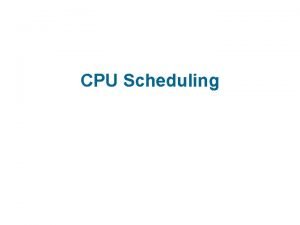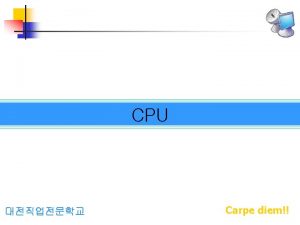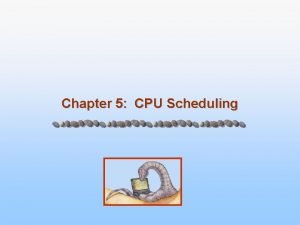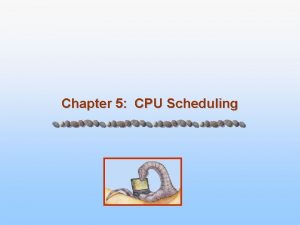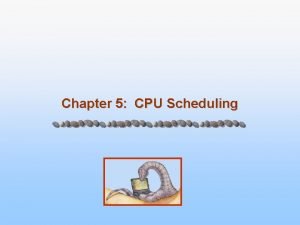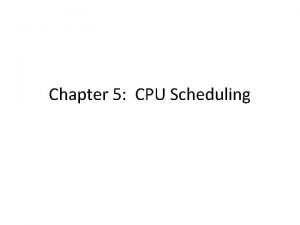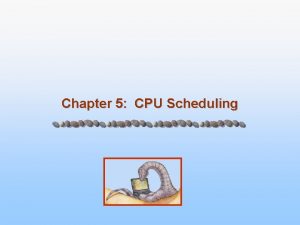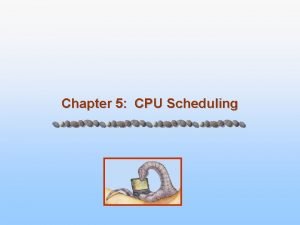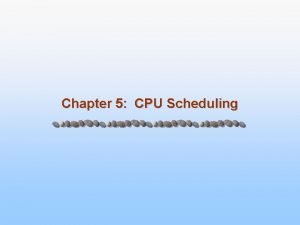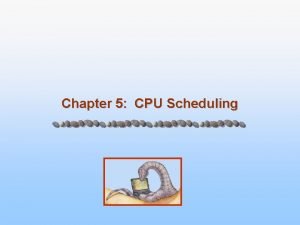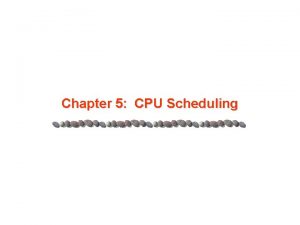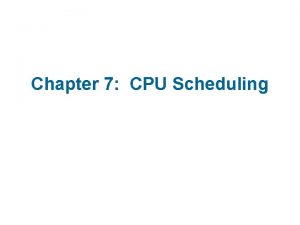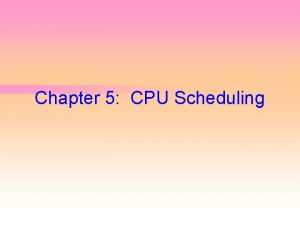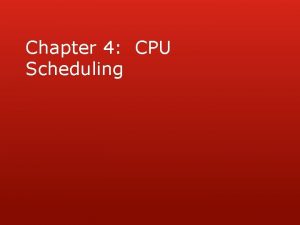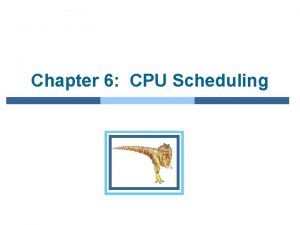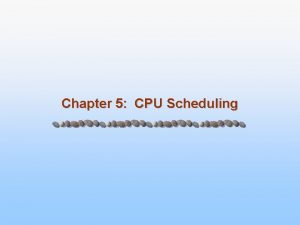Chapter 6 CPU Scheduling Operating System Concepts 9




























- Slides: 28

Chapter 6: CPU Scheduling Operating System Concepts – 9 th Edition Silberschatz, Galvin and Gagne © 2013

Chapter 6: CPU Scheduling n Basic Concepts n Scheduling Criteria n Scheduling Algorithms n Multiple-Processor Scheduling n Real-Time CPU Scheduling n Operating Systems Examples Operating System Concepts – 9 th Edition 6. 2 Silberschatz, Galvin and Gagne © 2013

Objectives n To introduce CPU scheduling, which is the basis for multiprogrammed operating systems n To describe various CPU-scheduling algorithms n To examine the scheduling algorithms of several operating systems Operating System Concepts – 9 th Edition 6. 3 Silberschatz, Galvin and Gagne © 2013

Basic Concepts n Maximum CPU utilization obtained with multiprogramming n CPU–I/O Burst Cycle – Process execution consists of a cycle of CPU execution and I/O wait n CPU burst followed by I/O burst n CPU burst distribution is of main concern Operating System Concepts – 9 th Edition 6. 4 Silberschatz, Galvin and Gagne © 2013

CPU Scheduler n Short-term scheduler selects from among the processes in ready queue, and allocates the CPU to one of them l Queue may be ordered in various ways n CPU scheduling decisions may take place when a process: 1. Switches from running to waiting state 2. Switches from running to ready state 3. Switches from waiting to ready 4. Terminates n Scheduling under 1 and 4 is nonpreemptive n All other scheduling is preemptive Operating System Concepts – 9 th Edition 6. 5 Silberschatz, Galvin and Gagne © 2013

Dispatcher n Dispatcher module gives control of the CPU to the process selected by the short-term scheduler; this involves: l switching context l switching to user mode l jumping to the proper location in the user program to resume that program n Dispatch latency – time it takes for the dispatcher to stop one process and start another running Operating System Concepts – 9 th Edition 6. 6 Silberschatz, Galvin and Gagne © 2013

Scheduling Criteria n What do we want to achieve from scheduling (One of the following): l Max CPU utilization – keep the CPU as busy as possible l Max Throughput – # of processes that complete their execution per time unit l Min Turnaround time – amount of time to execute a particular process l Min Waiting time – amount of time a process has been waiting in the ready queue l Min Response time – amount of time it takes from when a request was submitted until the first response is produced, not output (for time-sharing environment) Operating System Concepts – 9 th Edition 6. 7 Silberschatz, Galvin and Gagne © 2013

First- Come, First-Served (FCFS) Scheduling Process Burst Time P 1 24 P 2 3 P 3 3 n Suppose that the processes arrive in the order: P 1 , P 2 , P 3 The Gantt Chart for the schedule is: n Waiting time for P 1 = 0; P 2 = 24; P 3 = 27 n Average waiting time: (0 + 24 + 27)/3 = 17 Operating System Concepts – 9 th Edition 6. 8 Silberschatz, Galvin and Gagne © 2013

FCFS Scheduling (Cont. ) Suppose that the processes arrive in the order: P 2 , P 3 , P 1 n The Gantt chart for the schedule is: n Waiting time for P 1 = 6; P 2 = 0; P 3 = 3 n Average waiting time: (6 + 0 + 3)/3 = 3 n Much better than previous case Operating System Concepts – 9 th Edition 6. 9 Silberschatz, Galvin and Gagne © 2013

Shortest-Job-First (SJF) Scheduling n Associate with each process the length of its next CPU burst l Use these lengths to schedule the process with the shortest time n SJF is optimal – gives minimum average waiting time for a given set of processes l The difficulty is knowing the length of the next CPU request Operating System Concepts – 9 th Edition 6. 10 Silberschatz, Galvin and Gagne © 2013

Example of SJF Process. Arrival Time Burst Time P 1 0. 0 6 P 2 2. 0 8 P 3 4. 0 7 P 4 5. 0 3 n SJF scheduling chart n Average waiting time = (3 + 16 + 9 + 0) / 4 = 7 Operating System Concepts – 9 th Edition 6. 11 Silberschatz, Galvin and Gagne © 2013

Example of Shortest-remaining-time-first n Now we add the concepts of varying arrival times and preemption to the analysis Process. Aarri Arrival Time. T Burst Time P 1 0 8 P 2 1 4 P 3 2 9 P 4 3 5 n Preemptive SJF Gantt Chart n Average waiting time = [(10 -1)+(17 -2)+(5 -3))]/4 = 26/4 = 6. 5 msec Operating System Concepts – 9 th Edition 6. 12 Silberschatz, Galvin and Gagne © 2013

Priority Scheduling n A priority number (integer) is associated with each process n The CPU is allocated to the process with the highest priority (smallest integer highest priority) l Preemptive l Nonpreemptive n SJF is priority scheduling where priority is the next CPU burst time n Problem Starvation – low priority processes may never execute n Solution Aging – as time progresses increase the priority of the process Operating System Concepts – 9 th Edition 6. 13 Silberschatz, Galvin and Gagne © 2013

Example of Priority Scheduling Process. A arri Burst Time. T Priority P 1 10 3 P 2 1 1 P 3 2 4 P 4 1 5 P 5 5 2 n Priority scheduling Gantt Chart 0 P 1 P 5 P 2 1 6 P 3 16 P 4 18 19 n Average waiting time = 8. 2 msec Operating System Concepts – 9 th Edition 6. 14 Silberschatz, Galvin and Gagne © 2013

Round Robin (RR) n Each process gets a small unit of CPU time (time quantum q) l usually 10 -100 milliseconds. l After this time has elapsed, the process is preempted and added to the end of the ready queue. n If there are n processes in the ready queue and the time quantum is q, l each process gets 1/n of the CPU l No process waits more than (n-1)q time units. n Timer interrupts every quantum to schedule next process n Performance l If q is large FIFO l q small q must be large with respect to context switch time, otherwise overhead is too high 4 context switch < 10 micro sec Operating System Concepts – 9 th Edition 6. 15 Silberschatz, Galvin and Gagne © 2013

Time Quantum and Context Switch Time Operating System Concepts – 9 th Edition 6. 16 Silberschatz, Galvin and Gagne © 2013

Example of RR with Time Quantum = 4 Process Burst Time P 1 P 2 P 3 n The Gantt chart is: 24 3 3 n Better response than SJF Operating System Concepts – 9 th Edition 6. 17 Silberschatz, Galvin and Gagne © 2013

Multiple-Processor Scheduling n CPU scheduling more complex when multiple CPUs are available n Asymmetric multiprocessing – only one processor accesses the system data structures, alleviating the need for data sharing n Symmetric multiprocessing (SMP) – each processor is self- scheduling, all processes in common ready queue, or each has its own private queue of ready processes l Currently, most common l Load balancing attempts to keep workload evenly distributed n Processor affinity – process has affinity for processor on which it is currently running Operating System Concepts – 9 th Edition 6. 18 Silberschatz, Galvin and Gagne © 2013

Real-Time CPU Scheduling n Soft real-time systems l No guarantee as to when critical real-time process will be scheduled n Hard real-time systems l Real-time process must be serviced by its deadline Operating System Concepts – 9 th Edition 6. 19 Silberschatz, Galvin and Gagne © 2013

Operating System Examples n Linux scheduling n Windows scheduling Operating System Concepts – 9 th Edition 6. 20 Silberschatz, Galvin and Gagne © 2013

Linux Scheduling Through Version 2. 5 n Prior to kernel version 2. 5, ran variation of standard UNIX scheduling algorithm n Version 2. 5 moved to constant order O(1) scheduling time l l l l l Preemptive, priority based Two priority ranges: time-sharing and real-time Real-time range from 0 to 99 and nice value from 100 to 139 Map into global priority with numerically lower values indicating higher priority Higher priority gets larger q Task run-able as long as time left in time slice (active) If no time left (expired), not run-able until all other tasks use their slices All run-able tasks tracked in per-CPU runqueue data structure 4 Two priority arrays (active, expired) 4 Tasks indexed by priority 4 When no more active, arrays are exchanged Worked well, but poor response times for interactive processes Operating System Concepts – 9 th Edition 6. 21 Silberschatz, Galvin and Gagne © 2013

Linux Scheduling (Cont. ) n Real-time scheduling according to POSIX. 1 b l Real-time tasks have static priorities n Real-time plus normal map into global priority scheme n Nice value of -20 maps to global priority 100 n Nice value of +19 maps to priority 139 Operating System Concepts – 9 th Edition 6. 22 Silberschatz, Galvin and Gagne © 2013

Linux Scheduling in Version 2. 6. 23 + n Completely Fair Scheduler (CFS) n Scheduling classes Each has specific priority l Scheduler picks highest priority task in highest scheduling class l Rather than quantum based on fixed time allotments, based on proportion of CPU time l l n 2 scheduling classes included, others can be added 1. default 2. real-time Quantum calculated based on nice value from -20 to +19 Lower value is higher priority l Calculates target latency – interval of time during which task should run at least once l Target latency can increase if say number of active tasks increases l n CFS scheduler maintains per task virtual run time in variable vruntime Associated with decay factor based on priority of task – lower priority is higher decay rate l Normal default priority yields virtual run time = actual run time l n To decide next task to run, scheduler picks task with lowest virtual run time Operating System Concepts – 9 th Edition 6. 23 Silberschatz, Galvin and Gagne © 2013

CFS Performance Operating System Concepts – 9 th Edition 6. 24 Silberschatz, Galvin and Gagne © 2013

Windows Scheduling n Windows uses priority-based preemptive scheduling n Highest-priority thread runs next n Dispatcher is scheduler n Thread runs until (1) blocks, (2) uses time slice, (3) preempted by higher-priority thread n Real-time threads can preempt non-real-time n 32 -level priority scheme n Variable class is 1 -15, real-time class is 16 -31 n Priority 0 is memory-management thread n Queue for each priority n If no run-able thread, runs idle thread Operating System Concepts – 9 th Edition 6. 25 Silberschatz, Galvin and Gagne © 2013

Windows Priority Classes n n Win 32 API identifies several priority classes to which a process can belong l REALTIME_PRIORITY_CLASS, HIGH_PRIORITY_CLASS, ABOVE_NORMAL_PRIORITY_CLASS, BELOW_NORMAL_PRIORITY_CLASS, IDLE_PRIORITY_CLASS l All are variable except REALTIME A thread within a given priority class has a relative priority l TIME_CRITICAL, HIGHEST, ABOVE_NORMAL, BELOW_NORMAL, LOWEST, IDLE n Priority class and relative priority combine to give numeric priority n Base priority is NORMAL within the class n If quantum expires, priority lowered, but never below base Operating System Concepts – 9 th Edition 6. 26 Silberschatz, Galvin and Gagne © 2013

Windows Priorities Operating System Concepts – 9 th Edition 6. 27 Silberschatz, Galvin and Gagne © 2013

End of Chapter 6 Operating System Concepts – 9 th Edition Silberschatz, Galvin and Gagne © 2013
 Operating system concepts chapter 8 solutions
Operating system concepts chapter 8 solutions Operating system concepts chapter 5 solutions
Operating system concepts chapter 5 solutions Operating system concepts chapter 5 solutions
Operating system concepts chapter 5 solutions Disk scheduling policies
Disk scheduling policies Multiprocessor scheduling in os
Multiprocessor scheduling in os Turnaround time in os
Turnaround time in os Multilevel queue scheduling
Multilevel queue scheduling Sjf cpu scheduling
Sjf cpu scheduling First come first serve calculator
First come first serve calculator Cpu i/o
Cpu i/o Sjf cpu scheduling
Sjf cpu scheduling Cpu scheduling types
Cpu scheduling types A cpu scheduling algorithm determines an order
A cpu scheduling algorithm determines an order Cpu scheduling project
Cpu scheduling project Scheduling della cpu
Scheduling della cpu Cpu scheduling project
Cpu scheduling project Job scheduling vs process scheduling
Job scheduling vs process scheduling Operating system
Operating system Linux operating system concepts
Linux operating system concepts Operating system concepts with java
Operating system concepts with java Operating system concepts 6th edition
Operating system concepts 6th edition Type 0 hypervisor
Type 0 hypervisor Real time characteristics of embedded operating systems
Real time characteristics of embedded operating systems 교보 drm
교보 drm Basic concepts of os
Basic concepts of os Operating system concepts 11th
Operating system concepts 11th Operating system concepts essentials
Operating system concepts essentials Operating system concepts essentials
Operating system concepts essentials Peter baer galvin
Peter baer galvin



